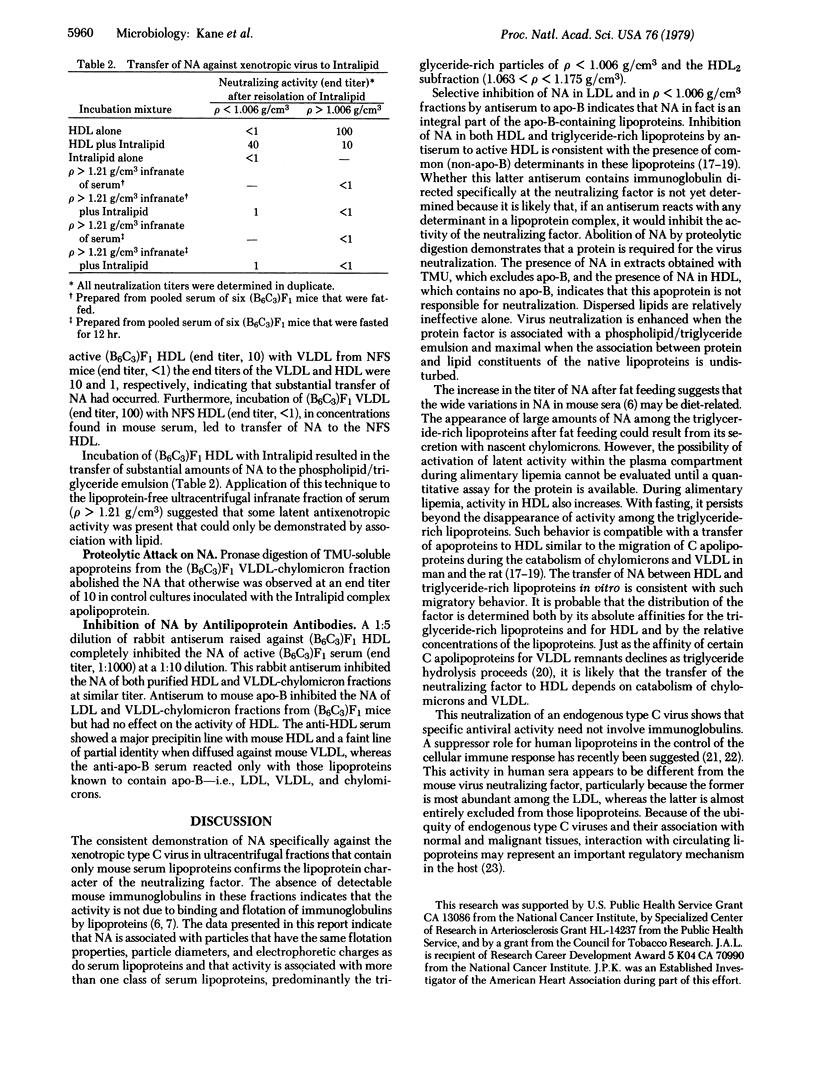Abstract
We have shown that the circulating lipoproteins of the mouse contain a potent inhibitor of infectivity of the xenotropic type C virus. This virus neutralization does not involve immunoglobulins or complement. After fractionation of the lipoproteins on the basis of particle size, flotation properties, and electrostatic charge, virus neutralizing activity is found primarily in the triglyceride-rich lipoproteins (predominantly the chylomicrons) and in the HDL2 subfraction of the high density lipoproteins. In fasted animals, activity resides chiefly in the high density lipoproteins. Neutralization titers increase strikingly during alimentary lipemia in both the lipoproteins of the ρ < 1.006 g/cm3 fraction and the high density lipoproteins. Increased activity persists in the high density lipoproteins after the lipemia recedes. Virus neutralizing activity is completely eliminated in all fractions by antiserum against high density lipoproteins and, in the triglyceride-rich fractions, by antiserum to murine apolipoprotein B. Complete removal of lipids markedly reduces the neutralizing activity of both classes of lipoproteins. Apolipoproteins delipidated with tetramethylurea retain some activity, which is enhanced by binding to a phospholipid-stabilized triglyceride emulsion and which is abolished by proteolytic digestion. We have demonstrated in vitro transfer of activity between high density and very low density lipoproteins of the mouse. These data indicate that xenotropic virus neutralization by normal mouse serum depends upon a protein that transfers among lipoprotein particles in a fashion analogous to the C apolipoproteins of other mammalian species.
Keywords: virus infectivity, lipoproteins
Full text
PDF




Selected References
These references are in PubMed. This may not be the complete list of references from this article.
- Bilheimer D. W., Eisenberg S., Levy R. I. The metabolism of very low density lipoprotein proteins. I. Preliminary in vitro and in vivo observations. Biochim Biophys Acta. 1972 Feb 21;260(2):212–221. doi: 10.1016/0005-2760(72)90034-3. [DOI] [PubMed] [Google Scholar]
- Curtiss L. K., Edgington T. S. Regulatory serum lipoproteins: regulation of lymphocyte stimulation by a species of low density lipoprotein. J Immunol. 1976 May;116(5):1452–1458. [PubMed] [Google Scholar]
- Eisenberg S., Rachmilewitz D. Interaction of rat plasma very low density lipoprotein with lipoprotein lipase-rich (postheparin) plasma. J Lipid Res. 1975 Sep;16(5):341–351. [PubMed] [Google Scholar]
- Fischinger P. J., Ihle J. N., Bolognesi D. P., Schäfer W. Inactivation of murine xenotropic oncornavirus by normal mouse sera is not immunoglobulin-mediated. Virology. 1976 May;71(1):346–351. doi: 10.1016/0042-6822(76)90118-5. [DOI] [PubMed] [Google Scholar]
- HAVEL R. J., EDER H. A., BRAGDON J. H. The distribution and chemical composition of ultracentrifugally separated lipoproteins in human serum. J Clin Invest. 1955 Sep;34(9):1345–1353. doi: 10.1172/JCI103182. [DOI] [PMC free article] [PubMed] [Google Scholar]
- Havel R. J., Kane J. P., Kashyap M. L. Interchange of apolipoproteins between chylomicrons and high density lipoproteins during alimentary lipemia in man. J Clin Invest. 1973 Jan;52(1):32–38. doi: 10.1172/JCI107171. [DOI] [PMC free article] [PubMed] [Google Scholar]
- Higgins J. M., Fielding C. J. Lipoprotein lipase. Mechanism of formation of triglyceride-rich remnant particles from very low density lipoproteins and chylomicrons. Biochemistry. 1975 Jun 3;14(11):2288–2293. doi: 10.1021/bi00682a002. [DOI] [PubMed] [Google Scholar]
- Kane J. P. A rapid electrophoretic technique for identification of subunit species of apoproteins in serum lipoproteins. Anal Biochem. 1973 Jun;53(2):350–364. doi: 10.1016/0003-2697(73)90081-x. [DOI] [PubMed] [Google Scholar]
- Kane J. P., Sata T., Hamilton R. L., Havel R. J. Apoprotein composition of very low density lipoproteins of human serum. J Clin Invest. 1975 Dec;56(6):1622–1634. doi: 10.1172/JCI108245. [DOI] [PMC free article] [PubMed] [Google Scholar]
- Leong J. C., Kane J. P., Oleszko O., Levy J. A. Antigen-specific nonimmunoglobulin factor that neutralizes xenotropic virus is associated with mouse serum lipoproteins. Proc Natl Acad Sci U S A. 1977 Jan;74(1):276–280. doi: 10.1073/pnas.74.1.276. [DOI] [PMC free article] [PubMed] [Google Scholar]
- Levy J. A. Autoimmunity and neoplasia. The possible role of C-type viruses. Am J Clin Pathol. 1974 Aug;62(2):258–280. doi: 10.1093/ajcp/62.2.258. [DOI] [PubMed] [Google Scholar]
- Levy J. A. Endogenous C-type viruses in normal and "abnormal" cell development. Cancer Res. 1977 Aug;37(8 Pt 2):2957–2968. [PubMed] [Google Scholar]
- Levy J. A. Host range of murine xenotropic virus: replication in avian cells. Nature. 1975 Jan 10;253(5487):140–142. doi: 10.1038/253140a0. [DOI] [PubMed] [Google Scholar]
- Levy J. A., Ihle J. N., Oleszko O., Barnes R. D. Virus-specific neutralization by a soluble non-immunoglobulin factor found naturally in normal mouse sera. Proc Natl Acad Sci U S A. 1975 Dec;72(12):5071–5075. doi: 10.1073/pnas.72.12.5071. [DOI] [PMC free article] [PubMed] [Google Scholar]
- Levy J. A. Xenotropic C-type viruses and autoimmune disease. J Rheumatol. 1975 Jun;2(2):135–148. [PubMed] [Google Scholar]
- Levy J. A. Xenotropic viruses: murine leukemia viruses associated with NIH Swiss, NZB, and other mouse strains. Science. 1973 Dec 14;182(4117):1151–1153. doi: 10.1126/science.182.4117.1151. [DOI] [PubMed] [Google Scholar]
- Lux S. E., John K. M., Brewer H. B., Jr Isolation and characterization of apoLp-Gln-II (apoA-II), a plasma high density apolipoprotein containing two identical polypeptide chains. J Biol Chem. 1972 Dec 10;247(23):7510–7518. [PubMed] [Google Scholar]
- Morse J. H., Witte L. D., Goodman D. S. Inhibition of lymphocyte proliferation stimulated by lectins and allogeneic cells by normal plasma lipoproteins. J Exp Med. 1977 Dec 1;146(6):1791–1803. doi: 10.1084/jem.146.6.1791. [DOI] [PMC free article] [PubMed] [Google Scholar]
- Rowe W. P., Pugh W. E., Hartley J. W. Plaque assay techniques for murine leukemia viruses. Virology. 1970 Dec;42(4):1136–1139. doi: 10.1016/0042-6822(70)90362-4. [DOI] [PubMed] [Google Scholar]
- Scanu A. M., Edelstein C. Solubility in aqueous solutions of ethanol of the small molecular weight peptides of the serum very low density and high density lipoproteins: relevance to the recovery problem during delipidation of serum lipoproteins. Anal Biochem. 1971 Dec;44(2):576–588. doi: 10.1016/0003-2697(71)90247-8. [DOI] [PubMed] [Google Scholar]


